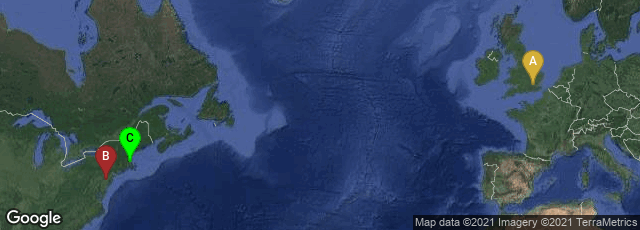
A: London, England, United Kingdom, B: Philadelphia, Pennsylvania, United States, C: Boston, Massachusetts, United States
In 1792 American inventor Jacob Perkins invented steel engraving for the process of banknote printing. In America Perkins was unable to commercialize the process successfully. Motivated by a £20,000 prize offered by the British government for development of unforgable banknotes, in 1818 Perkins moved to England. He and associates "set up shop in England, and spent months on example currency, still on display today. Unfortunately for them, Sir Joseph Banks thought that 'unforgable' also implied that the inventor should be English by birth. Sir Joseph Banks's successors awarded future contracts to the English printing company started with Charles Heath" (Wikipedia article on Jacob Perkins, accessed 10-21-2012).
In 1819 Perkins received British patent No. 4400 for: "Certain Machinery and Implements Applicable to Ornamental Turning and Engraving, and to the Transferring of Engraved or Other Work from the Surface of One Piece of Metal to another Piece of Metal, and to the Forming of Metallic Dies and Matrices; and also Improvements in the Construction and Method of Using Plates and Presses for Printing Bank Notes and other Papers, whereby the Producing and Combining various Species of Work is effected upon the same Plates and Surfaces, the Difficulty of Imitation increased, and the Process of Printing facilitated; and also an Improved Method of Making and Using Dies and Presses for Coining Money, Stamping Medals, and other Useful Purposes." The patent included six large folding engineering drawings.
In England Perkins entered into business arrangements with English engraver, currency and stamp printer, book publisher and illustrator Charles Heath. To produce steel engravings engravers such as Heath had to use special plates supplied by Perkins. These plates had to be printed on presses designed and provided by Perkins; both the plates and the presses were described in Perkins's patent.
In 1840 Perkins's methods reached true mass production when they were used to print the world's first adhesive postage stamp. The process, which proved the extreme durability of steel plates compared to any other available graphic reproduction medium of the time, remained in use until 1879:
"Henry Courbould made a drawing of Queen Victoria from the Medal struck on her accession to the throne for which Perkins, Bacon and Petch paid him £12.00. A piece of steel 3" square x 9/16" thick was annealed several times to remove the carbon and when completely soft the background was engraved with the aid of the geometric lathe, followed by the engraving of Queen's head and the inscription "Postage - One Penny". After hardening, the die became harder than it had been originally and 240 impressions were transferred to the printing plate using the Roll Transfer Press. This Master Die 1 was in use from 1840 to 1855 with master Die 2 being used until 1879 - a tribute to the excellence of Jacob Perkins' plate hardening system. It was proved that fully 400,000 imprints could be taken from a single plate without signs of wear. Altogether, over twenty-two thousand million stamps for Great Britain and the Colonies were printed by the Perkins' process during these years" (http://www.bphs.net/GroupFacilities/J/JacobPerkinsPrinting.htm, accessed 06-24-2012).
Hunnisett, Engraved on Steel: The History of Picture Production Using Steel Plates (1998) 112.